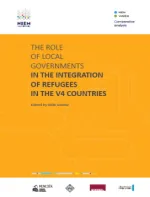The role of local governments in the integration of refugees in the V4 countries

NIEM Comparative Analysis 2021
The social integration of beneficiaries of international protection (BIPs) – including recognized refugees, beneficiaries of subsidiary protection and beneficiaries of temporary protection – has not been a traditional item on the social policy agenda of the Visegrad countries, with the exception of Czechia where it has deeper historical roots. As these countries joined the European Union in 2004, their legal and policy frameworks concerning asylum and integration were harmonized with the EU acquis, nonetheless, the topic was not a policy priority. When it became a policy priority, however, it did so in a very politicized framework. The refugee crisis of 2015-2016 made forced migration a crucial topic of the political discourse in an increasingly
securitizing manner, most importantly in Hungary, but also in the other
three V4 countries.
Yet, policies and discourses about migration and asylum evolved on a national level and focusing on the nation-state as a level of analysis and intervention, leaving little room to local differences. Despite the fact that the settlement of beneficiaries of international protection is rather uneven in the territory of all four countries (they prefer to stay in big cities), local governments have had little to say about the newcomers whose integration, at the end of the day, was a task related to local communities.